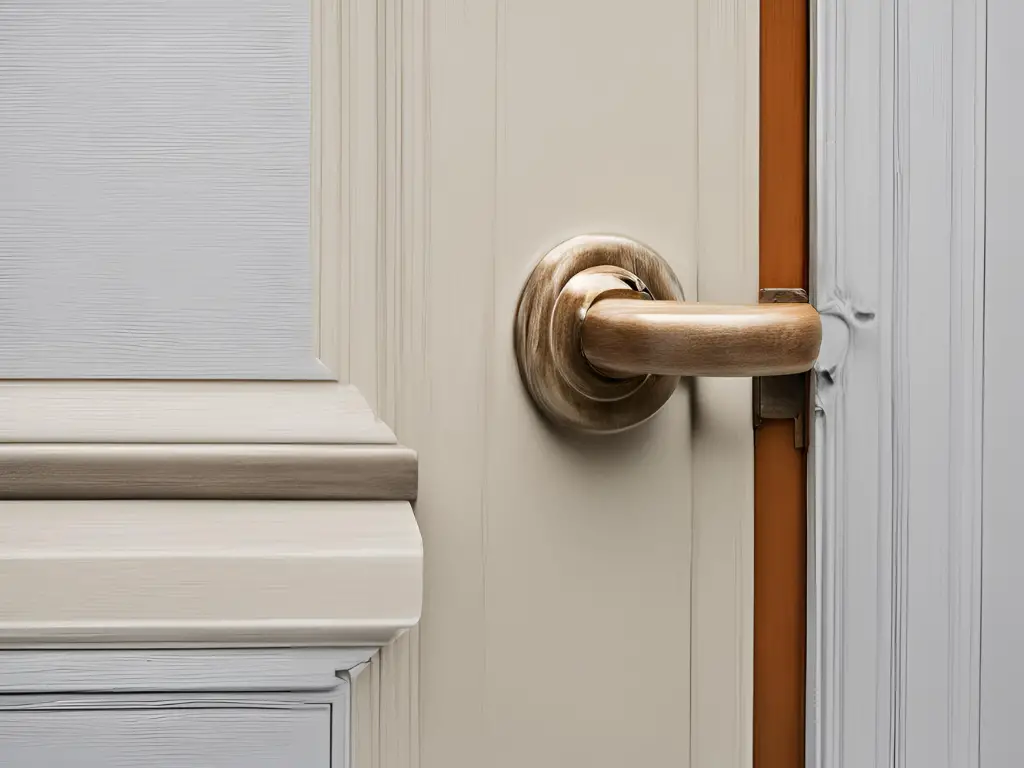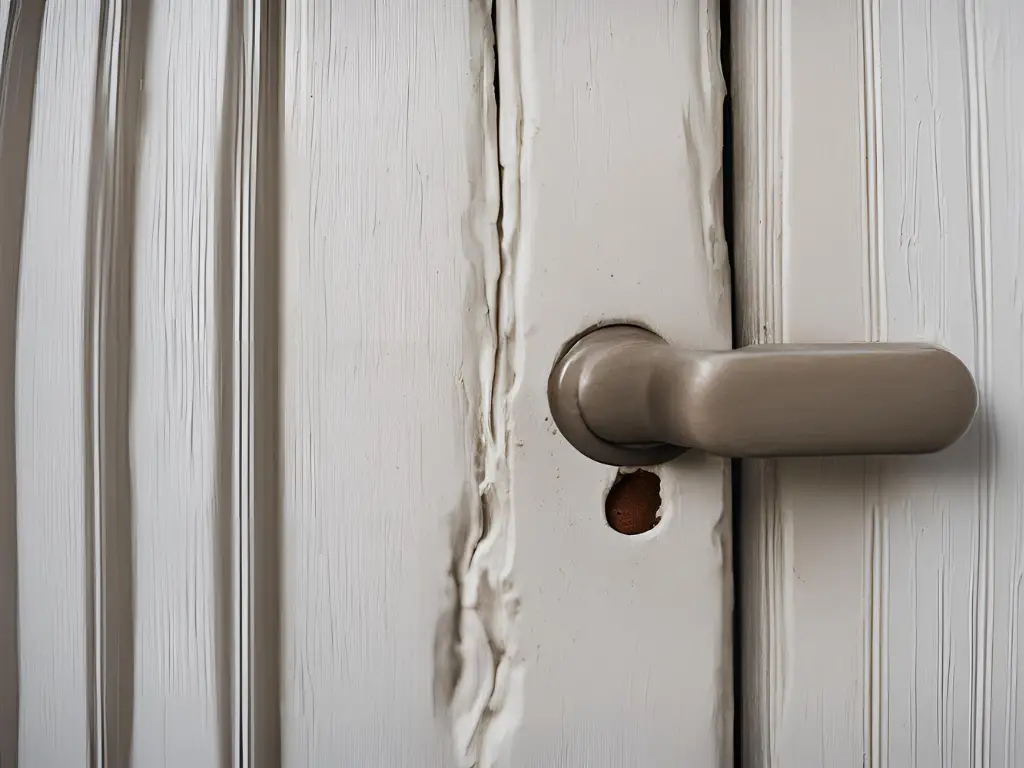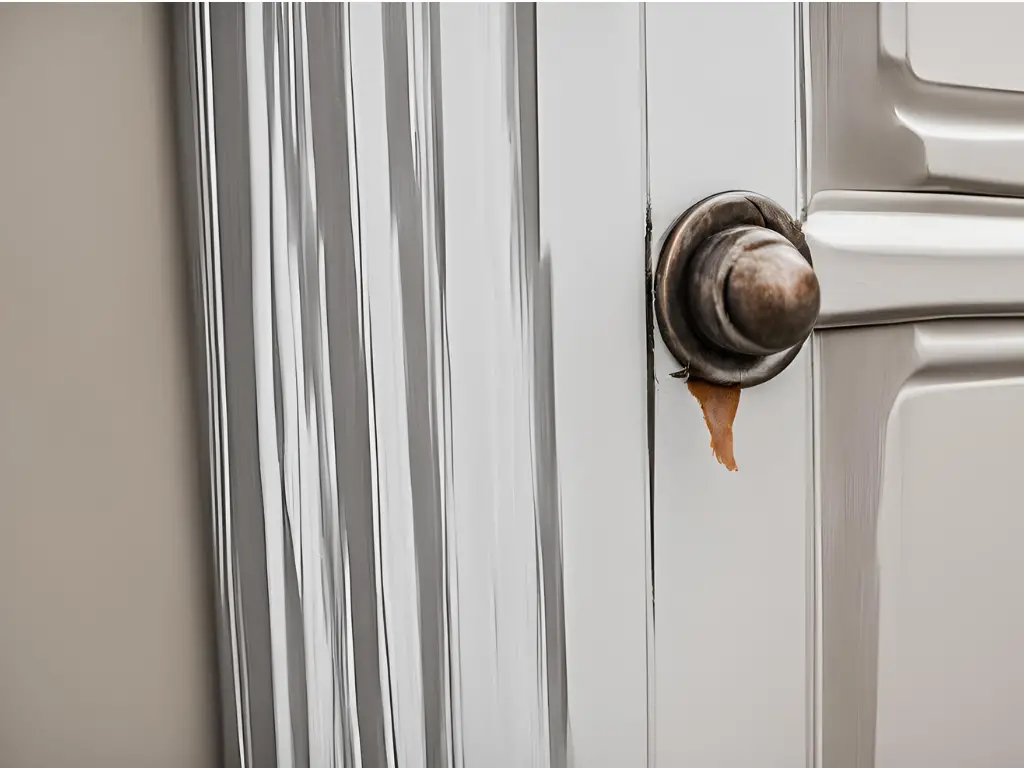To Dog Scratches On Door Fix, sand the area, apply wood filler, and re-stain or paint. Use a protective barrier to prevent future damage.
Dealing with dog scratches on doors can frustrate many pet owners. The sight of scratches not only tarnishes the aesthetics of wooden doors but can also lead to bigger maintenance issues if left unaddressed. Scratches typically happen as our canine companions express their desire to go outside or their excitement upon our return.
Addressing this problem involves a straightforward repair process, which, with the right tools and materials, can be a simple DIY task. Additionally, finding long-term solutions to train your dog or to shield your doors from their enthusiastic paws is crucial. By taking action early, you preserve the integrity and appearance of your home’s entryways and keep your furry friend from adopting destructive habits.
Introduction To Door Scratching
Is your furry friend leaving scratch marks on your doors? Door scratching is a common behavior among dogs. It can happen for many reasons. Understanding why it happens is the first step to fixing the issue. Let’s dive into why dogs scratch doors and how it impacts your home.
Common Reasons Dogs Scratch Doors
- Seeking Attention: Dogs often scratch doors to get the attention of their owners.
- Anxiety: Separation anxiety can lead a dog to scratch at doors, hoping to reunite with their owner.
- Wanting Outside: The call of nature or the excitement of the outdoors can prompt scratching.
- Boredom: A lack of stimulation can lead dogs to scratch doors as a way to entertain themselves.
Impact On Your Home
Door scratching can have unwanted effects on your home:
| Impact | Explanation |
|---|---|
| Damage to Doors | Scratches can ruin the finish and integrity of doors, leading to costly repairs. |
| Noise | Constant scratching can be a loud disturbance to household peace. |
| Aesthetic Appeal | Unsightly scratch marks can diminish the visual appeal of your home’s interior. |
Assessing The Behavior
Welcome to the ‘Assessing the Behavior’ section of our blog. Before you fix the scratches on your door, understand why your dog does this. Dogs communicate in ways humans need to learn. Scratches on doors are signs. Paying attention helps prevent further damage. Let’s explore the reasons behind this common canine habit.
Identifying Triggers
Dogs scratch doors for many reasons. Dissecting these triggers is crucial. List the times your dog scratches. Is it during a thunderstorm or when alone? Look for patterns. These hints will guide you towards solutions. Keep details like time of day and events in the house. This insight makes finding triggers easier.
- Separation anxiety: Does scratching start when you grab keys to leave?
- Boredom or excess energy: Does your dog get enough playtime?
- Need for bathroom breaks: Are scratches more frequent after meals or naptime?
- Outside stimuli: Squirrels or mail carriers may excite your dog.
Understanding Canine Body Language
Spotting your dog’s body cues is essential. Paws at the door might mix with whines or barks. Your dog’s posture tells a lot. A tucked tail and ears say one thing; a wagging tail, another. Study your pet’s actions closely. It’s an important step towards a scratch-free door.
| Body Language | What It Might Mean |
|---|---|
| Low-pitched barks | Defense or alert to potential threat |
| High-pitched yelps | Excitement or invitation to play |
| Whining or whimpering | Wanting attention or feeling anxious |
| Ears up or forward | Interest in something happening outside |
| Ears back | Fear, anxiety, or submission |
Recognizing what your dog’s behavior indicates is the first move. This observation stops scratches before they happen. Next, we’ll explore effective interventions. Our goal: happy dogs and pristine doors.
Immediate Temporary Solutions
Dog scratches on doors can be frustrating and damaging. Before finding a permanent solution or consulting a professional, you might want to try immediate temporary solutions. These methods can protect your doors and keep your furry friend happy. We will explore easy fixes that any dog owner can implement right away.
Protective Barriers
Placing protective barriers is a quick fix. It prevents direct contact between your dog’s claws and the door. Let’s consider the types of barriers you can use:
- Vinyl Door Protector: A clear, stick-on sheet that shields the door’s surface.
- Metal Kick Plate: A sturdy metal plate installed at the bottom of the door.
- Scratch Shield: A commercial product designed to cover and protect the door.
All these barriers are simple to install and available at most home improvement stores.
Distraction Techniques
Distractions can keep your dog’s attention away from the door. Try these engaging activities:
- Provide chew toys or puzzle feeders to keep them busy.
- Use a playpen to create a barrier while giving space to move around.
- Consider regular training sessions to improve behavior.
These techniques not only protect your doors but also enrich your dog’s life.

Long-term Training Strategies
Dogs scratching doors can be frustrating. But don’t worry! Long-term training strategies can help fix this behavior. Simple methods can teach your furry friend to stop. Train with patience and consistency for the best results.
Positive Reinforcement
Reward good behavior rather than punishing the bad. Every time your pup avoids scratching, give them a treat. Use verbal praise and physical affection to reinforce this positive behavior. Your dog will start to associate not scratching with rewards.
- Use dog treats or their favorite toy as a reward.
- Keep treats handy near the door.
- Be consistent with your rewards.
Desensitization Exercises
Desensitization can ease your dog’s anxiety. This will make the door less of a focus point. Start by touching the doorknob without opening the door. If your dog doesn’t react, reward them. Gradually increase the exposure.
- Touch the doorknob and wait for calm behavior before rewarding.
- Progress to opening the door a little, and then more each time.
- Continue to reward when your dog stays calm and scratch-free.
Professional Training Assistance
Sometimes a pro can make all the difference. Consider a certified dog trainer. They offer specialized knowledge and strategies. They can observe your dog in action. They then tailor a plan for you.
| Benefits of Professional Training |
|---|
| Custom behavior plans |
| Expert advice and techniques |
| Support and guidance |
Home Repairs And Prevention
Your furry friend’s love for scratching can lead to unwanted door damage.
It’s essential to address these marks not only for aesthetics but for the door’s integrity.
Let’s dive into effective ways to fix the damage and prevent future scratches, keeping your doors looking pristine.
Fixing The Damage
Door scratches can be unsightly, but fear not—they can be fixed! Before you start, ensure the door is clean and dry.
- Fill minor scratches with wood filler.
- For deeper gouges, use epoxy wood filler.
- Once dry, sand the area smoothly in line with the wood grain.
- Apply a coat of matching paint or stain for a seamless finish.
- Lastly, add a clear varnish to protect your hard work.
Choosing Scratch-resistant Materials
To stop future incidents, consider upgrading your door materials. Scratch-resistant doors or panels are a wise choice.
- Metal kick plates protect the door’s base.
- Vinyl door guards offer a clear, durable barrier.
- For a natural option, thick veneers resist damage well.
A sturdy dog gate can also keep your pooch away from the door altogether.

When To Seek Veterinary Advice
Many dogs scratch doors as part of normal behavior. Yet, some scratching can mean health worries. Pets don’t speak, but they show us signs. When those signs suggest discomfort or distress, a vet visit is wise. Dogs with persistent scratching may need expert care to relieve their symptoms.
Signs Of Anxiety Disorders
Dogs can feel anxious too. Look for these anxious behaviors:
- Excessive barking
- Restlessness
- Pacing
- Chewing
If you notice these along with scratching, your dog might be stressed.
Medical Causes Behind Scratching
Dog scratching isn’t always due to behavior. Sometimes, it’s medical. Medical reasons include:
| Skin Issues: | Allergies, mites, or infections can irritate the skin, causing scratching. |
|---|---|
| Paws Problems: | Wounds, splinters, or inflammations might affect paws, leading to door scratching. |
| Nervous System: | Neurological disorders may provoke unusual behaviors like excessive scratching. |
Medical troubles need vet help. The vet checkup might prevent further damage or ease your dog’s problems.

Frequently Asked Questions On Dog Scratches On Door Fix
Can You Fix Dog Scratches On Wood Door?
Yes, you can fix dog scratches on a wood door. Start by sanding the scratch, then fill it with wood filler, stain, or markers, and finish with a sealant for protection.
How Do You Fix Scratches On A Door?
Clean the scratched area thoroughly. Apply a filling compound if the scratch is deep. Sand the area once dry. Touch up with matching paint or wood stain. Finish with a clear sealant for protection.
How Do You Fix Dog Nail Scratches On Wood?
Clean the scratched area. Fill in the scratches with a wood filler or crayon. Sand the filled area gently. Stain or repaint to match the surrounding wood. Seal with a clear protective coat for a finished look.
How Do You Get Dog Scratches Out Of Glass Doors?
To remove dog scratches from glass doors, polish the area with a toothpaste or baking soda paste, then rinse. For deeper scratches, use a glass repair kit or cerium oxide. If necessary, hire a professional for severe damage.
Conclusion
To wrap things up, addressing dog scratches on your door doesn’t have to be daunting. With the right materials and a bit of patience, you can both protect your doors and train your furry friend. Remember, consistency is key in any repair or training method you choose.
Your doors can look pristine again, and with continued care, stay that way.

